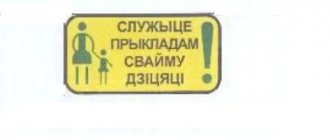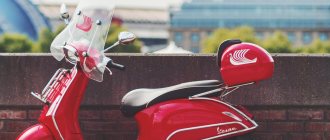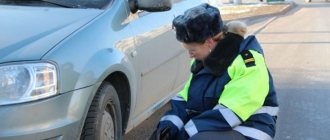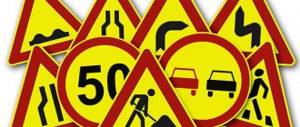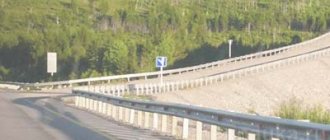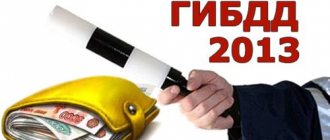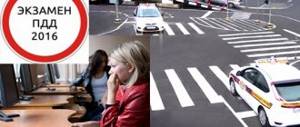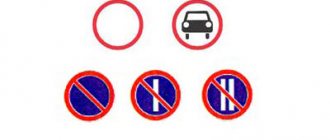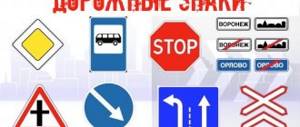What is a bicycle zone?
A new concept has been introduced into paragraph 1.2 of the traffic rules:
“ Bicycle zone ” is an area intended for the movement of cyclists, the beginning and end of which are indicated by signs 5.33.1 and 5.34.1, respectively.
This definition only says that the cycling zone must be marked with special signs. That is, if there are signs, the territory is a bicycle zone, but if there are no signs, it is not.
The concept of a cycling zone
The document adopted by the government introduced a new concept into the traffic rules - “bicycle zone”. This is a special area intended for the movement of cyclists. The boundaries of the bicycle zone are indicated by special signs . Also, along the entire road, special markings informing drivers are applied for cyclists.
Which road can be recognized as a cycling zone?
A special zone for the movement of cyclists can only be allocated on quiet streets where there is no too much traffic. An officially recognized bicycle zone can only be a section of the road limited by the appropriate signs and markings.
What's happened?
The Ministry of Transport of the Russian Federation has prepared important changes to the traffic rules - this is a draft amendment that changes a number of points of the Rules and introduces new points, as well as road signs and new terms. The new Rules are important to know not only for cyclists, but also for motorists.
As of May 22, 2021, the draft amendments have not entered into legal force and are not yet officially in force. We monitor information about new laws daily and will update the article as soon as changes come into force. You can subscribe to updates to this article using the link below.
Road signs for bicycle zones
Paths for cyclists can be separated from a pedestrian or roadway or combined.
They are laid along highways with a parallel or opposite direction of movement in relation to the main flow of cars.
Current road signs for designated bicycle zones indicating:
- A large arrow divided by a vertical line with a small one turned in the opposite direction and a bicycle on a blue background (5.11.2). There is a designated line on this road for bicycles to move in the oncoming lane.
- The images from the previous sign are crossed out (5.12.2). The end of the oncoming lane reserved for cyclists.
- A large arrow divided by a horizontal line with a small arrow facing the opposite direction and a bicycle (5.13.2; 5.13.4); bicycle and vertical arrow (5.14.2). Then the bicycle road begins.
- The images from the previous sign are crossed out (5.14.3). Then the bicycle road ends.
What signs should cyclists follow?
The rules that drivers of two-wheeled vehicles are required to learn are regulated in paragraphs 24.1 – 24.6 of the Traffic Regulations.
Places on the road where cyclists are allowed to move are marked with special stripes with signs:
1White up arrow with a bicycle in a blue square.
2The above image crossed out with a red line.
Only two-wheelers are allowed on these lanes.
Drivers of two-wheelers have the right to start driving in lanes designated for public transport. This point is taken into account in paragraph 18.2 of the traffic rules.
If there is a brick sign in a red circle, then cyclists are prohibited from entering.
Sign 3.1
You will find traffic signs for cyclists in pictures with names according to traffic rules at the beginning of the page.
Sign on traffic rules tickets
Which of the following signs prohibit the movement of moped drivers?
More details
Special regulations signs are responsible for entering or canceling certain driving modes. For example, special instructions signs can notify road users that a motorway begins next, where different rules apply than those on the previous section of the road. Also, special instructions signs include all signs that indicate a particular feature of a further section of the road. The beginning of a populated area, residential area, restricted parking area or their end, all of this refers to signs of special regulations. In addition to this function, this type of sign also indicates different traffic lanes in different areas.
It should be noted that failure to comply with the rules that establish special instructions signs is punishable by fines up to the deprivation of a driver's license. The type of traffic rules signs for special regulations 2019 has a common color scheme, which greatly simplifies their memorization and recognition on the road, and it is also always easy to determine the regulation that these signs refer to, since the images on them are quite simple and easily identifiable.
Signs prohibiting and allowing the movement of bicycles
A prohibitory signal tells the driver that he can’t ride his bike further - he needs to walk the distance to the first intersection or the end of the settlement, if there are no intersections. Cyclists are allowed to enter lanes reserved for public transport, but not always. If there is a combination of 2 symbols on the road - a prohibition and a permit sign, then the priority goes to the prohibition - you cannot enter the lane. Only cyclists under 14 years of age may ignore the sign for the start of the pedestrian zone ahead.
A pedestrian zone is different from a pedestrian path: drivers over 14 years of age can use the latter if driving on the right side of the road or shoulder is not possible, or if they are accompanying a child.
There are not many highways in Russia, but cyclists still enter them by mistake. This cannot be done. It is prohibited to drive lightweight 2-wheeled vehicles traveling at speeds less than 40 km/h on the highway. And in dedicated bicycle lanes, traffic priority belongs to bicycle drivers, and not to motorists or pedestrians.
Prohibiting and permissive traffic signals with symbols:
- Pedestrian, car, child with a ball and house (5.21). Then enter the zone of residential buildings, the traffic in which is regulated by the Russian Federation Traffic Regulations.
- A pedestrian in a blue circle with a red star on a gray background with the inscription “Zone” (5.33). Next is a section of the road where only pedestrians are allowed to move.
- White stripes crossed by a bridge on a green background (5.1). Then the highway begins.
- Pedestrian on a zebra crossing in a white triangle on a blue background (5.19.1; 5.19.2). Pedestrian crossing on the left or right.
- White line in red circle; "brick" (3.1). Entry is prohibited for all except route vehicles.
- White circle outlined in red (3.2). Movement is limited for everyone except route, service, postal vehicles, vehicles of enterprise employees and disabled people of the 2nd or 3rd groups.
- Bicycle on a gray background, outlined in red (3.9). Bicycles are prohibited.
Signs to mark the cycling zone
To indicate the bicycle zone, 2 new road signs have been introduced:
5.33.1 “Bicycle zone”.
The place where the bicycle zone begins.
5.34.1 "End of the bicycle zone"
You can duplicate the sign with road markings.
There is also more freedom for pedestrians in the bicycle zone. Clause 4.3 is canceled there.
| Cancellation of paragraph 4.3 in the bicycle zone. |
| 4.3. Pedestrians must cross the road at pedestrian crossings, including underground and overground ones, and in their absence, at intersections along the sidewalks or roadsides. At a controlled intersection, it is allowed to cross the roadway between opposite corners of the intersection (diagonally) only if there are markings 1.14.1 or 1.14.2 indicating such a pedestrian crossing. If there is no crossing or intersection in the visibility zone, it is allowed to cross the road at right angles to the edge of the roadway in areas without a dividing strip and fences where it is clearly visible in both directions. The requirements of this paragraph do not apply to bicycle zones. |
When crossing a road along a bicycle path and a pedestrian crossing, one bicycle and pedestrian traffic light is used.
| Traffic light signal |
| 6.5. If a traffic light signal is made in the form of a silhouette of a pedestrian and (or) a bicycle, then its effect applies only to pedestrians (cyclists). In this case, the green signal allows, and the red signal prohibits, the movement of pedestrians (cyclists). |
The speed limit in bicycle zones is 20 km/h .
Speed limit in bicycle zone
| Speed in a bicycle zone |
| 10.2. In populated areas, vehicles are allowed to move at a speed of no more than 60 km/h, and in residential areas, bicycle zones and courtyard areas, no more than 20 km/h . |
| Cyclists are allowed to pass through residential areas |
| 17.2. In a residential area, the through traffic of motor vehicles, practice driving, parking with the engine running, as well as parking of trucks with a permissible maximum weight of more than 3.5 tons outside specially designated areas and marked with signs and (or) markings is prohibited. |
Remember that a bicycle is not a motor vehicle?
Leaving a residential area by bicycle
Of course, in the bicycle zone, the main bicycles and the entire roadway belong to cyclists.
| Rules for driving in a bicycle zone |
| 24.11. In the bicycle zone: cyclists have priority over motor vehicles, and can also move along the entire width of the roadway intended for traffic in a given direction, subject to the requirements of paragraphs 9.11 - 9.3 and 9.6 - 9.12 of these Rules; pedestrians are allowed to cross the roadway in any place, subject to the requirements of paragraphs 4.4 - 4.7 of these Rules. |
Most of Chapter 9 of the rules for placing vehicles on the roadway in a bicycle zone applies to cyclists. The features of this chapter now need to be learned if you ride a bicycle. Don't forget that the speed limit of 20 km/h also applies to cyclists .
Although pedestrians are allowed to cross the roadway anywhere in the bicycle zone, other safety rules remain in force. Pedestrians are prohibited from driving along the roadway in a bicycle zone, unlike a residential zone. When crossing the road outside a pedestrian crossing, a pedestrian does not have priority over any vehicles.
Drivers of cars in the bicycle zone are guests. Whenever crossing paths, they are required to give way to cyclists.
Another amendment introducing exceptions to the ban on left turns on bicycles.
| Left turn on a bicycle |
| 24.8. Cyclists and moped drivers are prohibited from: ... turning left or turning around on roads with tram traffic and on roads with more than one lane for traffic in a given direction (except when turning left from the right lane is permitted, and with the exception of roads located in bicycle zones )>; |
There are hardly any 3 or 4 lane roads in the bicycle zone, but at T-junctions it is possible to turn left from the far right lane. In addition, at such intersections it may be prohibited to turn right, for example when entering a one-way road, then the cyclist simply has nowhere to move. This defect is eliminated by this amendment.
These are all the traffic rules changes for cyclists from December 14, 2021
Signs 4.5.2 “Pedestrian and bicycle path with combined traffic” and 4.5.3 “End of pedestrian and bicycle path with combined traffic”
Sign 4.5.2 “Pedestrian and bicycle path with combined traffic” is used to designate paths that are intended for the joint movement of pedestrians and bicycles in cases where pedestrians and bicycles are not separated into separate flows.
Bicycles move, maneuvering between pedestrians, without fear of receiving a claim for the inconvenience of moving together.
The main sign 4.5.2 is installed at the beginning of the path, a secondary sign is installed after each intersection with a road or similar pedestrian (cycle) path, as well as their combined version.
Sign 4.5.3 indicates, respectively, the end of a pedestrian and bicycle path with combined traffic. Thus, the coverage area of sign 4.5.2 extends to sign 4.5.3.
Signs 4.5.4 - 4.5.7 “Pedestrian and bicycle path with traffic separation” and “End of pedestrian and bicycle path with traffic division”
Signs “Pedestrian and bicycle path with traffic separation” are used to designate paths intended for the joint movement of pedestrians and bicycles, when the flows of pedestrians and bicycles are separated into separate flows.
In other words, there is either a constructive distinction between the flows of pedestrians and cyclists, and/or it is indicated by horizontal markings 1.2 (solid line), 1.23.2 (pedestrian symbol) and 1.23.3 (bicycle symbol).
The main signs 4.5.4, 4.5.5 are installed at the beginning of the path, repeated signs - after each intersection with a road or similar pedestrian (cycle) path, as well as their combined version.
Signs 4.5.6 and 4.5.7 indicate the end of a segregated pedestrian and bicycle path, and are placed at the end of a path intended for the combined movement of pedestrians and bicycles, symbolizing the end of the coverage of signs 4.5.4 and 4.5.5, respectively.
Sign "Intersection with a bicycle path"
Sign 1.24
The road sign “Intersection with a bicycle path” (1.24) is directly related to non-motorized vehicles. All road users need to pay attention to it.
Sign 1.24 is located:
1In cities and villages - 100 - 150 m before the intersection of automobile and bicycle roads.
2 Outside populated areas – 150 – 300 m before the intersection.
3At the distance indicated on the “Distance to object” sign, if this sign is installed next to 1.24.
Today, the traffic rules state that this intersection is an intersection, and accordingly, there is “interference from the right” - you must give way to a vehicle approaching from the right.
Sign 5.15.4 “Start of lane”
Sign 5.15.4 “Start of lane” indicates the beginning of a section of the middle lane of a three-lane road intended for traffic in a given direction. Those. before sign 5.15.4 there were two lanes on the roadway, after this sign another lane is added to the left and the road becomes three-lane.
Sign 5.15.4 is installed at the beginning of the transition marking line. It can be used to designate a lane intended for turning left or making a U-turn.
If sign 5.15.4 shows a sign prohibiting the movement of any vehicles, then the movement of these vehicles in the corresponding lane is prohibited.
There are cases when new lanes formed in front of intersections with “Start of Lane” signs and intended for turning right or left are not used for their intended purpose, but, for example, to pass fellow travelers at a higher speed.
There is no point in understanding the reasons for such violations; you just need to keep in mind that this happens and be careful. Two similar cases are discussed in the articles Leading in a “new” lane and Leading in a lane intended for turning right.
If you are tempted to bypass the flow of cars yourself in the lane intended for turning, then you need to remember that for this violation there is a fine of 1,500 rubles (at the time of publication) under Article 12.15 Part 1 of the Code of Administrative Offenses of the Russian Federation.
What does the sign look like?
A prescriptive or information sign looks like this:
- Shape - circle.
- Background is blue.
- The outline is white.
- The picture is a white bike.
Since December 2021, the concept of “Bicycle zone” has appeared in the traffic rules. Appearance of the sign: there is an inscription on a white rectangle at the top, and a bicycle is depicted at the bottom. The end of a zone or track is indicated by a red stripe through it.
In Russia there is another sign with a picture of a pedal vehicle, but it is a warning sign.
His appearance:
- Shape: triangle.
- Background is white.
- The outline is red.
- The picture is a black bicycle.
Purpose of the sign:
- Indicates the intersection of a highway and a bicycle path.
- Instructs transport drivers who plan to make a right turn crossing a bicycle path to give way to vehicles moving along this lane (including scooters, mopeds and scooters).
Where does the bike lane sign meet?
The sign is installed on the section of the roadway along which these vehicles are moving.
There are several types of bike paths:
- One way traffic. It can be on one or both sides of the roadway.
- With 2-way traffic. Such paths are most often located in places where bicycles are frequently used. For example, in active recreation areas for citizens (on tourist routes, in parks and squares).
- If the path also serves for the passage of pedestrians, then a pedestrian is depicted along with a bicycle on the mandatory sign.
- Independent. It can be either one- or two-sided. But this is already a full-fledged bicycle road. In some cases, it is equipped with individual lighting, and a sidewalk can be laid along it for pedestrian movement of citizens.
In New York City, for example, the bike lane is located on the right edge of the roadway and is separated from it by a double continuous lane or buffer zone. A sign indicating the possible passage of cyclists, as prescribed by the world traffic safety convention, must be located on every road on which they are allowed to travel.
Installed on the right side of the bike path if it is separated:
- lawn;
- curb;
- barrier;
- metal or reinforced concrete fencing, etc. device.
The “Bicycle path” sign may be posted above the path itself if this type of fastening is structurally possible.
How the sign is displayed on the asphalt
A road sign is installed at the beginning of the path, and the asphalt surface can additionally be painted. This coloring is horizontal marking 1.23.3. It has a drawing of a white bicycle. It happens that an additional arrow is drawn that shows the direction of movement.
The sign depicted on the asphalt is similar to the sign that is located above the road and has the same force.
The passage of non-motorized vehicles along these markings is prohibited.
What it looks like on the asphalt, coloring book
There is a sign where the bike path begins, and there is also painting on the surface of the road. This is horizontal marking 1.23.3. It is a white image of a bicycle. Sometimes an arrow is drawn just below, showing the direction of movement.
A “Bike Path” sign on the asphalt has the same meaning as one located above the road. He indicates that only non-motorized vehicles and mopeds are allowed to travel from this place. The territory ends with symbol 4.4.2.
No bicycle lane sign
On some sections of the roadway, cycling can be dangerous and therefore prohibited. Then there must be a sign “No bicycle path”. It is numbered 3.9 and has a slightly different name. The symbol is round, is an image of a non-mechanical vehicle on a white background, with a red border along the edge.
The exact name of 3.9 is “No cycling”. It contains a requirement that must be met from the installation site. 3.9 can be found:
- in front of a bridge, tunnel, overpass;
- at the beginning of the high-speed section of the route;
- in front of the industrial zone;
- at the beginning of the protected natural area.
Sometimes a non-mechanical vehicle is not allowed to drive in only one direction. Then next to 3.9 they put signs 8.3.1-8.3.3.
More on AutoLex.Net:
How to correctly interpret the sign “Movement without stopping is prohibited”, driving and stopping under the sign
Its influence ends at the nearest intersection. And if there is a sign next to 3.9, 8.2.1, you need to use it to judge where the symbol’s coverage area will end. After all, this sign indicates the distance at which its requirements should be met.
Watch this video about the concept of “Bike path”:
Sign “Intersection with a bicycle path”: appearance, rules of passage
The sign “Intersection with a bicycle path” (1.24) is directly related to non-motorized vehicles. Other road users should also be attentive to it. After all, the symbol warns that a cyclist may be in the path of the car.
Sign 1.24
1.24 according to GOST it is established:
- in a city or village - 100-150 m before the intersection of the bicycle road and the road;
- outside the populated area - 150-300 m before it;
- at the distance indicated on plate 8.1.1 if it is next to 1.24.
Previously, this symbol determined the priority of a mechanical vehicle. And the cyclist or moped driver was obliged to let the car pass. But now this clause has been excluded from the traffic rules. And the intersection of a bike path with a road is considered an intersection. If it is not regulated, there are no priority symbols, the rules of passage are:
At an intersection of equivalent roads, except in the case provided for in paragraph 13.11(1) of the Rules, the driver of a trackless vehicle is obliged to give way to vehicles approaching from the right.
That is, when a cyclist comes from this side, the car gives way. If they change roles, the driver of a non-motorized vehicle must wait.
All this means that a motorist cannot drive in the 1.24 zone, as in the expressway. At the border of the sign, he should slow down so that if something happens he has time to brake smoothly.
In addition, we should not forget about clause 13.1 of the traffic rules:
When turning right or left, the driver must give way to pedestrians and cyclists crossing the roadway onto which he is turning.
You cannot overtake in the influence zone 1.24; maneuvering in this area is dangerous. It is also prohibited to drive in reverse, as required by paragraph 8.12 of the traffic rules:
Reversing is prohibited at intersections and in places where turning around is prohibited in accordance with paragraph 8.11 of the Rules.
Where is the "Bicycle Path" sign prohibited?
There are places on the road where riding a two-wheeled non-motorized vehicle is not only unacceptable, but also dangerous. In such places, it is mandatory to place a “No bicycle path” sign, numbered 3.9. He displays a sign in the shape of a circle with a red border, depicting a bicycle on a white background. This sign can be seen:
- Before entering a tunnel, at the beginning of bridges, on overpasses;
- in places where the starting point of the expressway section is located;
- at the entrance to the industrial and communal zone;
- at the entrance to the protected area.
Sign 3.9
Lane direction sign
Let me immediately note that a road sign with a similar name has already been discussed within the framework of this article.
As for the “Lane Direction” sign, it is usually used on roads where the number of lanes for traffic in one direction exceeds the number of lanes for traffic in the other:
The sign is intended to help the driver navigate complex traffic conditions.
Sign 5.15.7 may contain miniature prohibitory signs, the requirements of which must also be observed.
New traffic rules for owners of two-wheeled vehicles
When riding a bicycle on a specially designated road, the owner of a two-wheeled vehicle must comply with the rules, which are also prescribed in.
Bicycle zone markings
To duplicate road signs, marking 1.24.6 has also been introduced into the rules:
| Marking | Description |
| 1.24.6 – duplication of road sign 5.33.1 “Bicycle zone” |
Please note that this marking can only be used in conjunction with road signs. This is because the definition of a bicycle zone only allows the use of signs. That is, if you come across the indicated markings, but there are no signs, then the territory is not a bicycle zone.
Priority in the bicycle zone
Let's consider clause 24.11 of the traffic rules:
24.11. In the bicycle zone:
- cyclists have priority over motor vehicles, and can also move along the entire width of the roadway intended for traffic in a given direction, subject to the requirements of paragraphs 9.11 - 9.3 and 9.6 - 9.12 of these Rules;
1. Please note that, unlike the pedestrian zone, (motorized vehicles) can drive
2. When driving, cyclists have priority over cars.
3. Cyclists can move along the entire opposite side of the roadway. Let me remind you that on other roads cyclists can only move at the right edge of the roadway.
Position of cyclists on the roadway
4. Cyclists must comply with the following rules:
- Do not drive into oncoming traffic if it is separated by continuous markings.
- Do not drive into oncoming traffic if there are 4 or more lanes on the road.
- On three-lane roads, enter the middle lane only for overtaking, passing, turning left and making a U-turn.
- Do not drive onto oncoming tram tracks.
- Cross the markings only when changing lanes.
- Do not drive onto medians, roadsides, sidewalks or pedestrian paths.
- Keep your distance.
- Avoid traffic islands and road structures on the right.
If you wish, you can independently refer to section 9 of the traffic rules and read the full text of the clauses of the rules relating to the movement of cyclists in the cycling zone.
Turn left and U-turn
Let's consider clause 24.8 of the traffic rules:
24.8. Cyclists and moped drivers are prohibited from:
- turn left or turn around on roads with tram traffic and on roads that have more than one lane for traffic in a given direction (except for cases where a left turn is allowed from the right lane, and with the exception of roads located in bicycle zones);
From this paragraph it follows that cyclists are prohibited from turning left on roads if there is more than 1 lane for traffic in a given direction. However, this rule does not apply in cycling zones . That is, you can turn left and turn around on any roads within the bicycle zone.
In addition, this rule does not apply outside bicycle zones if turning left is permitted from the right lane.
For example, if a T-junction only allows left turns and the signs allow you to turn left from the right lane, then a cyclist can make a left turn at that intersection.
Speed in a bicycle zone
Clause 10.2 of the traffic rules:
10.2. In populated areas, vehicles are allowed to move at a speed of no more than 60 km/h, and in residential areas and bicycle zones in courtyard areas no more than 20 km/h.
Please note that the speed inside the cycling zone is limited to 20 km/h .
On the one hand, this may cause dissatisfaction among cyclists, because... inside cycling zones they will have to slow down. On the other hand, I have never heard of a cyclist being ticketed for speeding, so it is unlikely that this will be strictly enforced within cycling zones either.
As for cars, they will be able to drive within the zones only at a speed of 20 km/h. That is, the speed of all vehicles will be approximately the same.
Sign 5.15.3 “Start of lane”
Sign 5.15.3 “Start of lane” indicates the beginning of an additional lane on an ascent or the beginning of a braking lane at intersections and junctions of roads. This sign is also used when the number of lanes for traffic in a given direction on the right increases.
Road sign 5.15.3 is installed at the beginning of the dividing line of such a lane.
This sign with the image of sign 4.6 “Minimum speed limit” is used in cases where it is necessary to set the minimum permissible speed on the left lane (or lanes) leading uphill.
This is done in order to increase the capacity of this section of the road, since cars should move faster in the left lanes.
The principle is simple, it is applicable on any road - whoever cannot move quickly takes the right lane and drives slowly, especially if the road leads uphill. Whoever can go faster takes the left lanes, ahead of the rest.
How is the bicycle lane designated?
The beginning of the lane for cyclists is indicated by sign 5.14.2:
If this sign is placed above a road, the lane for cyclists is the lane directly below the sign. If the sign is located to the right of the roadway, then the lane for cyclists is the right lane of the road.
The end of the lane for cyclists is indicated by a special sign 5.14.3:
Above are the main signs indicating a bicycle lane. In addition to them, several additional signs are used.
Signs 5.11.2 and 5.12.2 are installed on roads where the only oncoming lane is a lane for cyclists:
Signs 5.13.3 and 5.13.4 are installed in front of intersections if the road being crossed has a dedicated lane for cyclists directed towards the main flow of vehicles.
Sign 5.15.6 “End of lane”
Sign 5.15.6 “End of lane” indicates the end of the middle lane section on a three-lane road intended for traffic in a given direction. After this sign the road becomes “Narrower” on the left side, i.e. you will need to change lanes to the right.
The sign is installed at the beginning of the transition marking line, but you need to prepare for changing lanes earlier, without waiting for a cluster of cars to form at the end of the lane. This happens often during rush hours.
Recommendations for rebuilding are the same as stated “under” sign 5.15.5 (above in the text). The general rules for rebuilding, as well as the resolution of some controversial issues that arise during the rebuilding process, can be found in the series of articles Rebuilding.
Who can use the bike lane?
First of all, let's look at clause 9.9 of the traffic rules:
9.9. The movement of vehicles on dividing strips and shoulders, sidewalks and pedestrian paths is prohibited (except for the cases provided for in paragraphs 12.1, 24.2 - 24.4, 24.7, 25.2 of the Rules), as well as the movement of motorized vehicles (except mopeds) along the lanes for cyclists.
Thus, only bicycles and mopeds can travel in dedicated lanes for cyclists. Please note that vehicles are not permitted to enter the designated bicycle lane under any circumstances. Even if the lane is separated from the rest by a broken marking line.
This is a significant difference between a lane for cyclists and a dedicated lane for route vehicles.
Let's move on to cyclists and moped drivers.
Cyclists must use the bicycle lane:
24.1. Cyclists over 14 years of age must use bicycle paths, bicycle pedestrian paths, or bicycle lanes.
This requirement only applies to cyclists over 14 years of age. Cyclists under 14 years of age cannot ride in the dedicated lane.
I note that if there is a dedicated lane, cyclists over 14 years of age should not ride on the side of the road or on the sidewalk.
Moped drivers can also ride in the lane for cyclists, regardless of age (category M licenses are issued from the age of 16):
24.7. Moped drivers must move along the right edge of the roadway in a single file or in the bicycle lane.
Pedestrian traffic in the cycling zone
Let's consider clauses 24.11 and 4.3 of the traffic rules:
24.11. In the bicycle zone:
- pedestrians are allowed to cross the roadway at any place, subject to the requirements of paragraphs 4.4 – 4.7 of these Rules.
4.3. Pedestrians must cross the road at pedestrian crossings, including underground and overground ones, and in their absence, at intersections along sidewalks or curbs.
At a controlled intersection, it is allowed to cross the roadway between opposite corners of the intersection (diagonally) only if there are markings 1.14.1 or 1.14.2 indicating such a pedestrian crossing.
If there is no crossing or intersection in the visibility zone, it is allowed to cross the road at right angles to the edge of the roadway in areas without a dividing strip and fences where it is clearly visible in both directions.
The requirements of this paragraph do not apply to bicycle zones.
The peculiarity of the bicycle zone is that pedestrians can cross the road anywhere .
At the same time, when crossing the roadway, pedestrians must not interfere with bicycles and other vehicles (clause 4.5 of the traffic rules):
When crossing the road outside a pedestrian crossing, pedestrians, in addition, must not interfere with the movement of vehicles and exit from behind a standing vehicle or other obstacle that limits visibility without making sure that there are no approaching vehicles.
As for the rules for the movement of pedestrians on the road, they are exactly the same here as in other places. That is, pedestrians must walk on the sidewalk and not along the roadway.
In conclusion, I suggest you read the full text of the updated traffic rules:
Traffic regulations from April 8, 2021
Well, the next article discusses the stopping of vehicles by customs officers, updated stopping rules, as well as several other interesting innovations.
What are the penalties?
Article 12.29 of the Administrative Code, parts 2 and 3, states that the driver of a 2-wheeled vehicle bears administrative and financial liability for ignoring bicycle signs. The penalty is a fine of 800 rubles.
If, as a result of an unlawful action, damage was caused to the health or property of third parties, the cyclist must compensate the cost of the damage caused to the victim, and the amount of the administrative fine increases several times in relation to the original one.
Fines for bike lanes
In the territory marked with the symbol 4.4.1, you can only drive a non-mechanical vehicle, as well as a moped or scooter. Cars have nothing to do there. But drivers often ignore the ban. Violators face Part 2 of Article 12.15 of the Administrative Code:
Driving on bicycle or pedestrian paths or sidewalks in violation of the Traffic Rules entails an administrative fine of two thousand rubles.
Stopping and parking in the zone of influence of 4.4.1 is also prohibited by one of the provisions of paragraph 12.4 of the traffic rules. For these actions, the car driver will receive a fine of 500 rubles. in accordance with Part 1 of Article 12.19 of the Code. And in both cases, the traffic police officer has the right to apply Part 1 of Article 12.16 of the Code of Administrative Offenses (ignoring the requirements of signs and markings), that is, to demand payment of another 500 rubles.
More on AutoLex.Net:
Travel rules and penalties for violating them on a traffic island
Theoretically, a pedestrian can also be punished for using a bicycle path. After all, this category of traffic participants has the right to move in the zone of influence of symbol 4.4.1 only in the absence of a sidewalk. Pedestrians should stay to the right and not interfere with cyclists.
Otherwise, you can run into a fine of 500 rubles. according to Part 1 of Art. 12.29 Code of Administrative Offenses or a warning from a traffic police inspector. This, of course, does not mean that the driver of a non-motorized vehicle or moped can hit a pedestrian with impunity.
The “Bicycle path” sign is still rarely seen in Russia. And it causes bewilderment among many motorists, and some completely neglect it. And in vain, because the number of cyclists is growing every year. This means that the number of separate lanes and separate zones for them will also increase.
